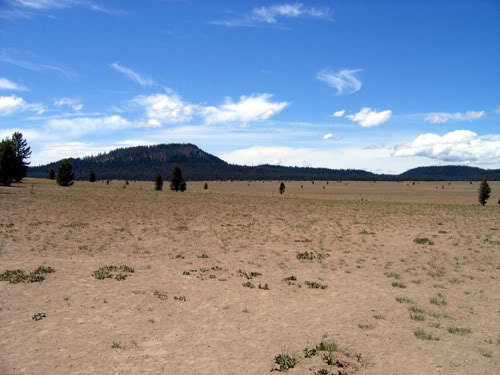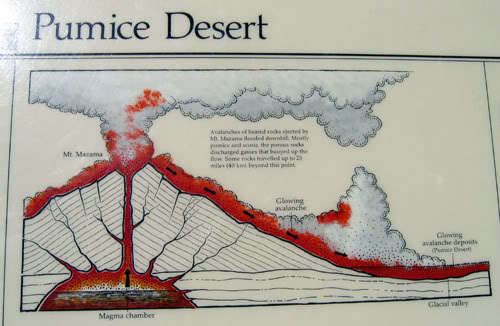About 7,700 years ago, a cataclysmic eruption of Mt. Mazama occurred, forming what is now Crater Lake. This eruption caused avalanches of pumice and other volcanic rocks to race down the slopes and flood the valley with deposits over 100 feet deep.
Today, the Pumice Desert is a reminder of what happened so many years ago. Located north of Crater Lake, the desert is largely devoid of plants but filled with fields of pumice deposits.

The Pumice Desert is made up of mostly pumice and scoria.
Pumice can be distinguished by its light color, porosity, and light weight. Pumice is a textural term for a volcanic rock that is a solidified foam composed of highly microvesicular glass pyroclastic with very thin, translucent bubble walls extrusive igneous rock. It is commonly, but not exclusively of silicic or felsic to intermediate in composition (e.g. rhyolitic, dacitic, andesite, pantellerite, phonolite, trachyte), but occurrences of basaltic and other compositions are known. Pumice is commonly pale in colour, ranging from white, cream or grey, but can be green brown or black. It forms when gases exsolving from viscous magma nucleate bubbles which cannot readily decouple from the viscous magma prior to chilling to glass. Pumice is a common product of explovie eruptions (plinian and ignimbrite-forming) and commonly forms zones in upper parts of silicic lavas. Pumice has an average porosity of 90%, and initially floats on water.
Scoria is usually reddish, darker and heavier than the pumice fragments. Scoria differs from pumice in being denser, with larger vesicles and thicker vesicle walls; it sinks rapidly. The difference is the result of the lower viscosity of the magma that formed scoria.

Informational sign that was in the parking area (no longer there):

References:
http://www2.nature.nps.gov/geology/parks/crla/
http://en.wikipedia.org/wiki/Crater_Lake_National_Park
http://www.virtuar.com/click/2005/crater_lake/
http://en.wikipedia.org/wiki/Pumice
Permission for this Earthcache was granted by the Crater Lake National Park because of Earthcaches Leave-No-Trace principles, and the fact there is no placement of a physical cache container. The placement of any type of cache container is prohibited anywhere within the Park.
Per the National Park Service: Please respect the natural beauty and significance of the area. All vehicles must stay on established and designated roads and parking areas - and this law is strictly enforced to protect the Pumice Desert.
In order to log this cache:
1. Why is this pumice desert largely devoid of plants? Email me your theory.
2. Email me the number of people in your group.
(Optional) Please take a picture of your group at the Pumice Desert and post it to the gallery.